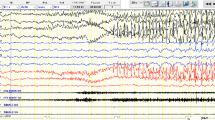Abstract
Of the epileptic syndromes beginning in early infancy, we described the clinical and electrical characteristics of early myoclonic encephalopathy (EME) and Ohtahara syndrome (OS), and the differential diagnosis between the two syndromes, reviewing previous articles and our own study of 6 cases with EME and 15 cases with OS.
With regard to the clinical seizure types, the main seizure type was tonic spasms in OS while myoclonias, especially erratic myoclonias, and frequent partial seizures were predominant in EME. The suppression-burst (S-B) pattern was a common feature of both syndromes, although their form, time of appearance, and duration of appearance differed considerably. The S-B pattern in OS was characterized by periodic and consistent appearances during both waking and sleeping states, whereas in EME, the S–B pattern was enhanced by sleep and often hot manifested in the awake states. OS showed a specific pattern of evolution as age-dependent epileptic encephalopathy with concomitant EEG change while EME had no specific evolution with age. In OS, obvious brain lesions such as brain malformations were often seen. In contrast, frequent occurrence of familial cases suggested some kind of congenital metabolic disorder as the etiological factor in EME.
Similar content being viewed by others
References
Commission of Classification and Terminology of the International League Against Epilepsy. Proposal for revised classification of epilepsies and epileptic syndromes.Epilepsia 1989; 30: 389–399.
Aicardi J and Goutieres F. Encephalopathie myoclonique neonatale.Rev EEG Neurophysiol 1978; 8: 99–101.
Aicardi J. Early myoclonic encephalopathy (neonatal myoclonic encephalopathy). In: Roger J, Bureau M, Dravet Cet al eds.Epileptic Syndromes in Infancy, Childhood and Adolescence 2nd edn. London : John Libbey, 1992; 13–23.
Dalla Bernardina B, Dulac O, Bureau Met al. Encephalopathie myoclonique precoce avec epilepsie.Rev EEC Neurophysiol 1982; 12: 8–14.
Dalla Bernardina B, Dulac O, Fejerman Net al. Ealry myoclonic epileptic encephalopathy (EMEE).Eur J Pediatr 1983; 140: 248–252.
Murakami N, Ohtsuka Y, Ohtahara S. Early infantile epileptic syndromes with suppression-bursts: Early myoclonic encephalopathy vs Ohtahara syndrome.Jpn J Psychiatry Neurol 1993; 47 : 197–200.
Dalla Bernardina B, Aicardi J, Goutieres Fet al. Glycine encephalopathy.Neuropaediatrie 1979; 10: 209–225.
Terasaki T, Yamatogi Y, Ohtahara Set al. A long-term follow-up study on a cases with glycine encephalopathy.No To Hattatsu 1988; 20: 15–22.
Lombroso CT. Early myoclonic encephalopathy, early infantile epileptic encephalopathy, and begin and severe infantile myoclonic epilepsises: a critical review and personal contributions.J Clin Neurophysiol 1990; 7 : 380–408.
Ohtahara S, Ishida T, Oka Eet al. On the specific age dependent epileptic syndrome; the early-infantile epileptic encephalopathy with suppression-burst.No To Hattatsu 1976; 8: 270–280.
Ohtahara S. A study on the age-dependent epileptic encephalopathy.No To Hattatsu 1977; 9:2–21.
Ohtahara S. Clinico-electrical delineation of epileptic encephalopathies in childhood.Asian Med J 1978; 21: 499–509.
Ohtahara S and Yamatogi Y. Evolution of seizures and EEG abnormalities in childhood onset epilepsy. In: Wada JA and Ellingson RJ, eds.Clinical Neurophysiology of Epilepsy, Handbook of Electroencephalography and Clinical Neurophysiology, Revised Series, Amsterdam : Elsevier, 1990; vol.4 : 457–177.
Ohtasuka Y, Ogino T, Murakami Net al. Developmental aspects of epilepsy with special refernece to age-dependent epileptic encephalopathy.Jpn J Psychiatry Neurol 1986; 40: 307–313.
Yamatogi Y and Ohtahara S. Age-dependent epileptic encephalopathy: a longitudinal study.Folia Psychiatr Neurol Jpn 1981; 35: 321–331.
Martin HJ, Deroubaix-Tella P, Thelliez Ph. Encephalopathie epileptique neonatale a bouffees periodiques.Rev EEG Neurophysiol 1981; 11: 397–403.
Konno K, Miura Y, Suzuki Het al. A study on clinical features of the early infantile epileptic encephalopathy with suppression burst of Ohtahara syndrome.No To Hattatsu 1982; 14: 395–404.
Clark M, Gill J, Noronka Met al. Early infantile epileptic encephalopathy with suppression burst: Ohtahara syndrome.Dev Med hild Neurol 1987; 29 :508–519.
Bermejo AM, Martin VL, Arcas Jet al. Early infantile epileptic encephalopathy: a case associated with hemimegalencephaly.Brain Dev 1992; 14: 425–428.
Robain O, Dulac O. Early epileptic encephalopathy with suppression bursts and olivary-dentate dysplasia.Neuropediatrics 1992; 23: 162–164.
Ohtahara S,OhtsukaY, Yamatogi Yet al. Early-infantile epileptic encephalopathy with suppression-bursts. In: Roger J, Bureau M, Dravet Cet al. eds.Epileptic Syndromes, in Infancy; Childhood and Adolescence, 2nd edn. London : John Libbey, 1992; 25–34.
Harding BN and Boyd SG. Intractable seizures from infancy can be associated with dentato-olivary dysplasia.J Neurological Science 1991; 104; 157–165.
Hirata Y, Ishikawa A, Somiya K. A case of linear nevus sebaceous syndrome associated with early-infantile epileptic encephalopathy with suppression burst (EIEE).No To Hattatsu 1985; 17: 577–582.
Tatsuno M, Hayashi M, Iwamoto Het al. Leigh’s encephalopathy with wide lesions and early infantile epileptic encephalopathy with burst-suppression: an autopsy case.No To Hattatsu 1984; 16 : 68–75.
Ohtahara S, Ohtsuka Y, Yamatogi Yet al. The early-infantile epileptic encuphalopathy with suppression-bursts: developmental aspects.Brain Dev 1987; 9 : 371–376.
Schlumberger E, Dulac O, Plouin P. Early infantile epileptic syndrome (s) with suppression-burst: nosological considerations. In: Roger J, Bureau M, Dravet Cet al. eds.Epileptic Syndromes in Infancy, Childhood and Adolescence, 2nd edn. London : John Libbey, 1992 : 35–42.
Author information
Authors and Affiliations
Rights and permissions
About this article
Cite this article
Ohtahara, S., Ohtsuka, Y. & Oka, E. Epileptic encephalopathies in early infancy. Indian J Pediatr 64, 603–612 (1997). https://doi.org/10.1007/BF02726112
Issue Date:
DOI: https://doi.org/10.1007/BF02726112



